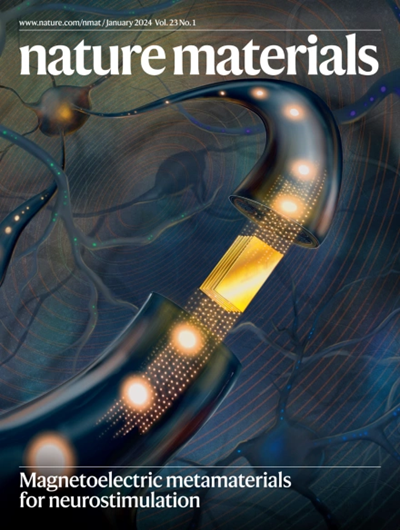范德华铁电体中机械释放极化气泡。
IF 38.5
1区 材料科学
Q1 CHEMISTRY, PHYSICAL
引用次数: 0
摘要
由于铁电拓扑结构在非易失性和超高密度信息存储的新时代中的令人兴奋的应用,引起了人们的广泛关注。然而,这些织构在很大程度上仍然依赖于给定的异质结构和工程邻近层来平衡竞争能量。在这里,我们报道了范德华铁电晶体CuInP2S6中的高密度极化气泡,而不需要空间限制的异质结构。从压电响应力显微镜观察到,气泡域的形成和分布存在于极性相的固有共存中。最重要的是,相比可以很容易地通过外部刺激(如机械力)来调整,使迷宫域能够通过涉及极性相竞争和柔性电的机制被操纵成高密度的孤立气泡,这是通过密度功能理论和相场建模揭示的。我们的发现不仅提供了以受控方式创建拓扑结构的见解,而且还展示了基于范德华铁电体中气泡域的潜在存储应用。本文章由计算机程序翻译,如有差异,请以英文原文为准。
Mechanically liberating polarization bubbles in van der Waals ferroelectrics.
Ferroelectric topological textures have sparked intensive interest, due to their exciting applications in a new era of non-volatile and ultrahigh-density information storage. However, these textures remain largely dependent on the given heterostructures with engineered neighbouring layers to balance the competing energies. Here we report high-density polarization bubbles in van der Waals ferroelectric crystals CuInP2S6, without the need for a spatially confined heterostructure. From piezoresponse force microscopy, it is observed that the formation and distribution of bubble domains exist in the inherent coexistence of polar phases. Crucially, the phase ratio can be facilely tailored by external stimuli such as mechanical force, enabling the labyrinth domains to be manipulated into high-density isolated bubbles through a mechanism involving polar phase competition and flexoelectricity, as revealed through density functional theory and phase-field modelling. Our findings not only provide insights into the creation of topological structures in a controlled manner but also demonstrate potential memory applications based on bubble domains in van der Waals ferroelectrics.
求助全文
通过发布文献求助,成功后即可免费获取论文全文。
去求助
来源期刊

Nature Materials
工程技术-材料科学:综合
CiteScore
62.20
自引率
0.70%
发文量
221
审稿时长
3.2 months
期刊介绍:
Nature Materials is a monthly multi-disciplinary journal aimed at bringing together cutting-edge research across the entire spectrum of materials science and engineering. It covers all applied and fundamental aspects of the synthesis/processing, structure/composition, properties, and performance of materials. The journal recognizes that materials research has an increasing impact on classical disciplines such as physics, chemistry, and biology.
Additionally, Nature Materials provides a forum for the development of a common identity among materials scientists and encourages interdisciplinary collaboration. It takes an integrated and balanced approach to all areas of materials research, fostering the exchange of ideas between scientists involved in different disciplines.
Nature Materials is an invaluable resource for scientists in academia and industry who are active in discovering and developing materials and materials-related concepts. It offers engaging and informative papers of exceptional significance and quality, with the aim of influencing the development of society in the future.
 求助内容:
求助内容: 应助结果提醒方式:
应助结果提醒方式:


